Class B
Class C
Class D
Class K
PTP Audio Solid 12.
Class Deletions
Thorens TD 309 Tri-Balance not currently available in the US; Hanns T-30, Kuzma Stabi SD, Music Hall MMF 9.1, all not auditioned in a long time.
Tonearms
Class A
 |
Artemis Labs SA-1: $8300 ✩ Designed in Germany by Frank Schröder and made in the US, the Artemis Labs SA-1 is built around a dense, compact plinth comprising a layer of ebony sandwiched between two layers of bamboo. It has a 15-lb platter of aircraft-grade aluminum alloy and an outboard motor controller designed to compensate for load changes due to varying LP modulations. Though it lacked the forceful attack and tightly focused images of other comparably priced turntables, the SA-1 was "among the least congested, and most open-sounding, airy, and tuneful turntables I've ever reviewed—at any price," said MF. (Vol.32 No.10) |
 |
Avid Diva II SP: $4495 The well-built Avid Diva II SP has a tungsten-carbide/sapphire ball and inverted stainless-steel bearing affixed to the hub of a three-legged chassis of cast aluminum. Instead of the spring suspensions found in more expensive Avid models, the Diva II SP uses a three-layer elastomer system that includes a "tailored Sorbothane compound" incorporated into each of the support legs. Upgrades over the stock Diva II include a 14-lb machined-aluminum platter and a DSP-based voltage-synthesizing outboard power supply. Though it had a generally cool, detached sound with a slightly lean midrange, the Diva II SP produced fast attacks, long decays, tuneful bass, and rock-solid, three-dimensional images. "Combined with the SME 309 tonearm ($2000), I'm not sure what's better, or even as good, for $6000," said MF. (Vol.34 No.1) |
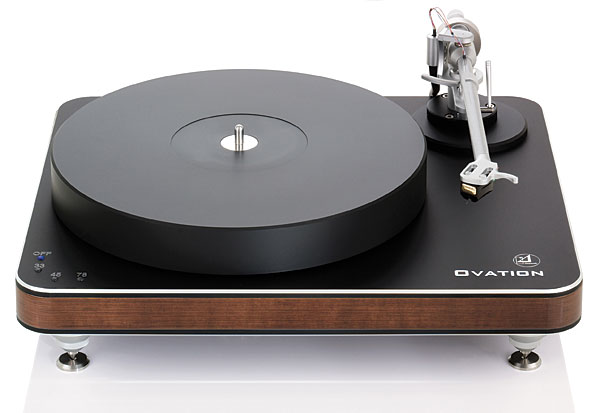 |
Clearaudio Ovation: $5500 with tonearm Using technology found in Clearaudio's more expensive Innovation series, the elegant-looking, belt-driven, three-speed Ovation measures 16.5" W by 6" H by 14" D and weighs 34 lbs. It uses a decoupled DC motor and has a resonance optimized chassis of Panzerholz and machined aluminum, a 1.5"-thick polyoxymethylene platter, and self-adjusting speed control. More nuanced and resolving than Clearaudio's entry-level Concept, the Ovation had a smooth, cohesive, and organic overall sound that combined sweet highs, a warm midrange, and taut bass, said EL. Compared to EL's Bel Canto digital front-end, the Ovation offered greater midbass body, but lacked some image depth and bass extension. Price without tonearm is $4300. (Vol.35 No.10 Read Review Online) |
 |
Oracle Paris: $5000, as reviewed The newest turntable from Canada's Oracle Audio Technologies is finished in a stunning high-gloss red lacquer and uses a carbon-fiber tonearm based on Pro-Ject's 9cc. To both minimize the effects of harmful vibrations and allow for easy, accurate leveling, the platter and tonearm have been cleverly isolated from the turntable's subchassis, plinth, and AC synchronous drive motor. Oracle's Micro Vibration Silicone Damping Device, a tonearm-damping system comprising a stationary trough and silicone bath, further reduces vibrations. Setup was simple. Though it wasn’t as quiet as AD's reference Garrard 301 and lacked that player's tonal color and texture, the Paris performed especially well with up-tempo rock music, exhibiting good timing, a punchy low end, and clean highs. Price includes tonearm and moving-coil cartridge; base price for turntable is $3150. (Vol.34 No.10 Read Review Online) |
 |
Clearaudio Concept: $1400 with tonearm $$$ The sleek, stylish Concept is a plug’n’play, belt-driven turntable with a decoupled DC motor and integral Clearaudio Verify tonearm, available with either the Concept MC moving-coil cartridge (add $800) or Concept MM moving-magnet cartridge (add $200). Though its attack transients were soft and its deep-bass extension limited, the Concept produced black backgrounds, solid and three-dimensional images, and a clean, smooth midrange. "Exceptionally attractive, easy to set up and use, and better built than its price would suggest," concluded MF. "High Class C" says EL.With Clearaudio's standard Concept moving-magnet cartridge in place, EL noted a slightly opaque, closed-in treble, but was nevertheless impressed by the Concept's fleshy, detailed midrange and rich upper bass. Switching to the Concept MC cartridge resulted in even greater midrange detail and palpability, and a sweeter, more extended treble, he said. (Vol.34 No.6, Vol.35 No.8 Read Review Online) |
 |
Rega RP3: $1095 $$$ Though similar in appearance to Rega's P3-24, the RP3 uses Rega's new RB303 tonearm and a completely redesigned plinth. The RB303 has a more rigid armtube, a revised three-point cartridge mount, and a new headshell, counterweight, and bearing assembly. The plinth now incorporates a flat, 4mm brace of superhard phenolic resin that couples the tonearm mount to the bearing assembly, both atop and below the plinth, to reduce mass and increase rigidity. Compared to the P3-24, the RP3 sounded leaner and cleaner, with a tighter and better-controlled bottom end, said MF. "The RP3 is a plug’n’play package that's beautifully built, well engineered, and sounds wonderful," he concluded. Compared to the VPI Traveler, the RP3 consistently produced faster transients and more aggressive, precise imaging for an overall sound that was snappy and exciting, but lacked the Traveler's liquidity, bottom-end control, and rhythmic stability, said SM. Price includes Elys 2 moving-magnet cartridge; base price for turntable with tonearm is $895. Optional Belt Drive: $59; Rega TT PSU: $395 (Vol.34 No.12, Vol.35 No.11) |
 |
VPI Traveler: $1299 The first VPI product codeveloped by Harry Weisfeld and his son Mathew, the Traveler is designed for easy setup and meant to appeal to a younger generation of music lovers. It uses an AC synchronous motor built directly into a rigid, compact chassis of Delrin and aluminum; a machined aluminum platter damped with a stainless-steel disc; a high-quality bearing assembly capable of driving a 20-lb platter; and a dedicated 10"-long, spring-loaded tonearm with a double-gimbal bearing for horizontal and vertical movement. The Traveler combined delicate highs, a clean midrange, outstanding low-end control, and awesomely silent backgrounds with an overall ease and fluidity that SM found intoxicating. Compared to the Rega RP3, the Traveler lacked transient speed and precision but offered greater clarity, presence, and rhythmic authority. SM feels solid Class B is the correct rating, but MF says high Class C. Price is for standard black finish; a red, white, or blue finish adds $100. (Vol.35 No.11 Read Review Online) |
 |
Music Hall USB-1: $249 The two-speed, belt-driven USB-1 bears a striking resemblance to the iconic Technics SL-1200 turntable. It comes equipped with an aluminum platter and felt platter mat, an S-shaped tonearm with detachable headshell, a serviceable Audio-Technica AT3600L moving-magnet phono cartridge, antiskating and pitch controls, and a thick dustcover. The USB-1 had a slower, darker, less rhythmically assured sound than the Rega RP-1, but produced eerily quiet backgrounds and solid stereo imaging. SM partnered the USB-1 with the Audioengine 5 powered speakers for "a stripped-down, badass, bitchin’ little system." Converting vinyl to WAV files via the USB-1's built-in phono preamp, USB output, and Audacity software was a simple but tedious process. (Vol.34 No.5 Read Review Online) |
 |
Rega RP1: $445 $$$ The plug’n’play RP1 (for Rega Planar One) replaces Rega's popular P1. Nearly identical to the earlier model in size and shape, the RP1 uses an Ortofon OM5e moving-magnet cartridge, but trades the P1's MDF platter for one of phenolic resin and adds Rega's new, solidly built RB101 tonearm. Additionally, the P1's drab gray finish is exchanged for the RP1's choice of White, Cool Gray, or Titanium. Compared to the P1, the RP1 delivered more drive, better focus, and was the more confident, purposeful, and authoritative player. "Rega's RP1 looks good, is easy to set up, and plays records like it means it," said SM. AD shared SM's enthusiasm: "It's not just that I can’t imagine $445 buying more happiness; I can’t imagine so modest an investment in money and effort buying more music." The RP1 Performance Pack Upgrade was easy to install and resulted in a bigger soundstage, deeper silences, and greater resolution of low-level detail, said SM. "A no-brainer," agreed AD. (Vol.34 Nos.2, 4, & 5 Read Review Online) |
PTP Audio Solid 12.
Class Deletions
Thorens TD 309 Tri-Balance not currently available in the US; Hanns T-30, Kuzma Stabi SD, Music Hall MMF 9.1, all not auditioned in a long time.
Tonearms
Class A
 |
Artemis Labs TA-1: $3950 Designed by Frank Schröder and made in the US, the TA-1 is a 9" tonearm with hybrid-ceramic bearings, polished kingwood armtube, and large brass counterweight. Vertical tracking force, stylus rake angle, antiskate, azimuth, and overhang are all adjustable. The TA-1 sounded poised, uncompressed, and sweet, with a treble range that was clean but free of undue emphasis or unnatural texture, said AD. "I already think of the Artemis as one of the most recommendable tonearms—of any length or type—I've had the pleasure of using," he concluded, recommending a Class A rating. MF demurs, feeling Class B the appropriate rating. (Vol.36 No.2 Read Review Online) |
 |
Brinkmann 10.5: $6300 ✩ A Breuer-like gimbaled-bearing design that features an armtube described by the designer as a "high-speed, double-concentric, ceramic-plated, self-damping transmission device." JI uses a Brinkmann arm on his Oracle with great success. (Vol.28 No.5) |
 |
Continuum Audio Labs Cobra: $18,000 ✩ The Cobra's odd shape—it's wider and higher in the middle—is designed to make the center of the arm as stiff and free of resonances as possible. The Cobra also includes original and ingenious methods for azimuth stabilization and adjustment. "The Caliburn-Cobra produced the most convincing, believable, solid, and alive sound picture I've heard," said MF. Though its tonal balance was similar to that of the Kuzma 4Point, the Cobra sounded less energetic and less natural, decided MF. (Vol.29 Nos.1 & 6, Vol.34 No.10, Vol.35 No.7 Read Review Online) |
 |
Durand Tonearms Telos: $19,500 The beautiful Telos, Durand's top model, is a 12", medium-mass tonearm made of a superbly sculpted and finished piece of wood. It comes in an attach‚-style wooden case and includes a full set of high-quality setup tools and accessories: LED flashlight, loupe, pivot-to-spindle-distance gauge, and alignment gauge. The "constrained unipivot" design provides relatively easy azimuth adjustment and uses a Swiss-made point of nonmagnetic stainless steel and a sapphire cup. With the Lyra Atlas cartridge mounted in its headshell, the Durand Telos sounded "addictively glorious," with outstanding harmonic richness and a relaxed sense of musical flow. Though bass response was well textured and relatively well controlled, the Telos lacked some bottom-octave solidity and punch, decided MF. (Vol.35 No.10) |
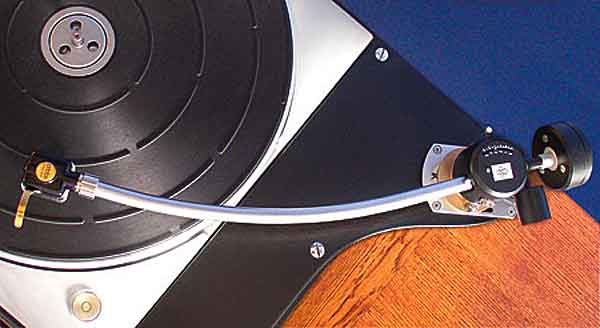 |
EMT 997: $5295 ✩ The banana-shaped EMT 997 tonearm employs a fixed-pivot, high-mass design and has a detachable headshell. Its effective length of 307mm (12") works to minimize tracking-angle error and distortion. Though it sacrificed timbral neutrality, imparting well-recorded vocals with some "mid-to-upper-mid bumps and dips," the 997 impressed Art with its ability to convey the inherent tension of recorded music. "The EMT 997 was the least wimpy, least wispy tonearm I've ever heard," he said. If willing to invest the time and effort necessary for proper setup and installation, the user will be rewarded with "an almost indescribably great deal of pleasure," AD added. (Vol.31 Nos.7 & 9 Read Review Online) |
 |
Graham Phantom II Supreme: $5500–$6300 Replacing the long-recommended B44 (reviewed in Vol.28 No.9, Vol.29 No.1, Mk.I, Vol.32 No.10, Vol.35 No.7, Mk.II Read Review Online), the Graham was just as detailed and uncolored as the Kuzma 4Point but lacked some speed and coherence, said MF. Price is for 9" Chrome Version. See "Analog Corner" in the April 2013 issue. |
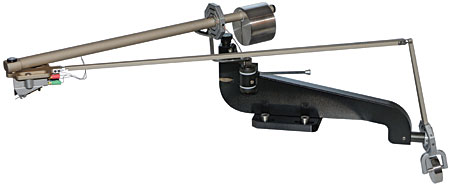 |
HiFiction Thales AV: $12,500 In this unique design, a two-piece mechanism comprising a long horizontal arm and a shorter vertical arm are attached to the back of the headshell by a pair of precision sapphire bearings. As the entire tonearm moves in an arc across the record, the headshell pivots precisely to maintain groove tangency. The Thales produced open, airy highs, deep lows, stable stereo imaging and soundstaging, and ultraclean transients and sibilants, said MF. Requires careful setup. (Vol.33 No.10 Read Review Online) |
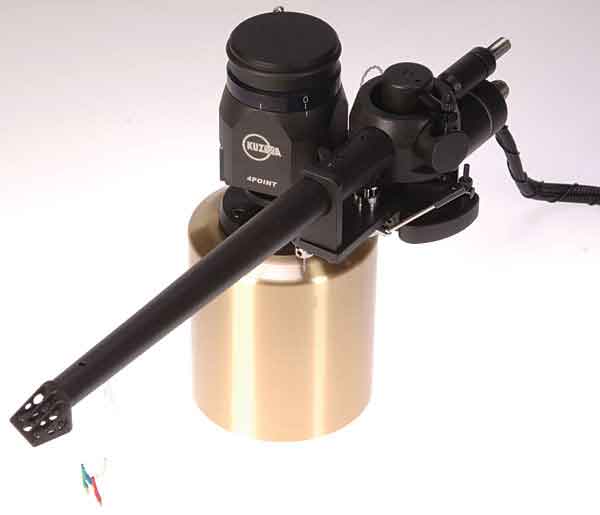 |
Kuzma 4Point: $6500 Designed by Franc Kuzma, this brilliant pivoted tonearm takes its name from its four-point bearing system: Four carefully arranged points contact four cups, permitting the arm to move in both the vertical and lateral planes while avoiding the chatter of gimbaled bearings and the instability of unipivot designs. It has an effective length of 11", a pivot-to-spindle distance of 10.3", an overhang of 0.6", an effective mass of 0.4oz, and a total weight of 3.63 lbs. Its removable headshell made swapping cartridges painless, while adjustment of VTF, VTA, antiskating, and azimuth were all relatively simple. With its outstanding immediacy, transparency, and overall coherence, the 4Point consistently exceeded Mikey's expectations. Compared to the combo of Continuum Cobra arm and Ortofon A90 cartridge, the 4Point with Lyra Titan i offered greater timbral, textural, and image solidity, said MF. "I'm in love," he concluded. Compared with the Continuum Audio Labs Cobra, the Kuzma sounded more natural and more energetic. "The Kuzma 4Point may be the finest tonearm out there, period," said MF. The Kuzma matched the Graham Phantom II Supreme's detail retrieval and neutrality but offered greater speed and coherence, said MF. Also offered with regular phono cables/no RCA box for $5800. (Vol.34 Nos.9 & 10, Vol.35 No.7 Read Review Online) |
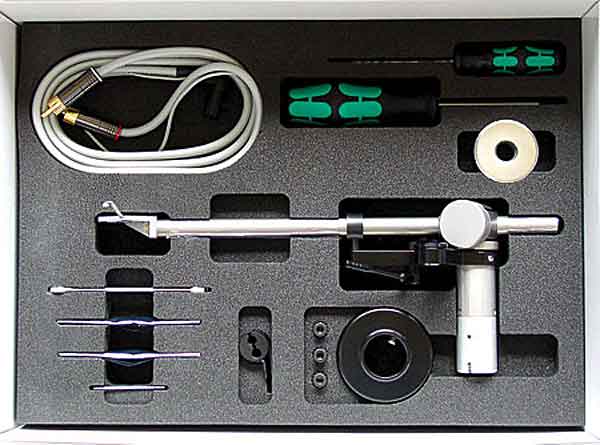 |
Linn Ekos SE: $4950 ✩ Outwardly identical to the original Ekos in all but color, the Ekos SE is machined from a titanium tube in an effort to smooth out resonant peaks, while its stainless-steel main pillar and bearing cradle work to maintain perfect bearing adjustment in the face of temperature extremes and user abuse. The "beautifully finished" SE comes packaged with a selection of tools, a Linn T-Kable interconnect, and a new iteration of Linn's cable clamp. With its strong, tight bass and solid aural images, the Ekos SE produced a "cleaner, more dramatic, and more enjoyable" listening experience, said AD. "Other, more exotic arms may give better results in some settings, but I can't think of a more consistent—and consistently recommendable—tonearm. It's a Martin D-28, a BMW 3-series, a bottle of Bombay Sapphire: It will please any sane, reasonable person," he sums up. (Vol.30 No.10 Read Review Online) |
 |
SME 312S: $4000 ✩ The 312S is a 12" tonearm with a tapered armtube made of pressure die-cast magnesium for strength, rigidity, and low mass. With fit’n’finish to match the no-nonsense precision of SME's 20/12 turntable, the 312S includes a secure sliding-track overhang-adjustment mechanism, a spring-loaded VTA post, and a silicone-filled damping trough with adjustable paddle. SME has produced "a tonearm that has all of the 12" arm's theoretical advantages and none of its disadvantages," MF said. (Vol.32 No.5 Read Review Online) |
 |
Spiral Groove Centroid: $6000 The Centroid is a fluid-damped unipivot design that gives the user fine adjustment of all relevant parameters. It was extremely quiet, with stunning resolution and clarity, and had an uncanny ability to reproduce the tonal and dynamic elements of deep bass notes. "The Centroid tonearm may be the best tonearm I've heard. It is not leaving my listening room," declared BD. The Spiral Groove SG1.1-Centroid turntable-tonearm combo offered black backgrounds, rock-solid bass, natural tone color, and outstanding detail retrieval, said Mikey. A universal version with standard arm mount is also now available. (Vol.33 No.6 Read Review Online, Vol.35 No.11) |
 |
Thomas Schick 12" Tonearm: $1675 $$$ ✩ Made in Germany by Thomas Schick and imported by Oswalds Mill Audio, the Schick 12" tonearm is intended to combine the greater-than-average length and mass of certain vintage models with the high-quality bearings of modern arms. It offers superb fit and finish, with a clean, spare bearing cradle and a smoothly solid pickup-head socket. Though lacking the spring-loaded downforce and other refinements of the EMT 997—and, thus, some measure of the more expensive arm's performance—the Schick is characterized by a big, clean, substantial sound, with an especially colorful bottom end: "a superb performer," according to AD, who also verified the correctness of the Schick's geometry with Keith Howard's ArmGeometer freeware. According to Art, "The Schick tonearm is an outstanding value and easily the most accessible transcription-length arm on the market." (Vol.33 Nos.3 & 6; Vol.34 No.10 Read Review Online) |
 |
Tri-Planar Mk.VII UII: $5800 This venerable tonearm maker has a new owner (see "Analog Corner," March 2001). The Mk.VII UII builds on earlier versions, "with a larger-diameter headshell tube, a larger damping trough, and redesigned bearings, featuring handmade hardened and polished needle cones." Many of the arm's parts are still made by Papier's machinist in Maryland. "Right out of the box," MF said, "it was obvious that the Tri-Planar's build quality is still topnotch." But MF still has a beef with the headshell screw slots—"way too wide." Still, "the Tri-Planar was one of the first...captured-bearing tonearms to offer easily adjustable VTA and azimuth adjustment." MF: "The sound of the Tri-Planar had not changed appreciably since I last auditioned it: It offered unerring, rock-solid image and soundstage stability. The bass was extended and lithe, and high-frequency transients were cleanly presented. The picture was airy and big....In any case, the Tri-Planar's ability to resolve low-level detail was superb, and its tonal balance and frequency extension were exemplary." Price includes 1m cable/RCA plug termination or 10" wire to RCA-jack junction box. BD's reference tonearm as of 2009; he got great results with the Tri-Planar on a Spiral Groove SG-2 turntable. The Tri-Planar Precision Mk.VII sounded vivid and solid on the Spiral Groove SG2, with rich tonal colors and textures, but was never overly euphonic, said BD. (Vol.18 No.2, Vol.21 No.3, earlier versions; Vol.24 No.7, Mk.VI Ultimate; Vol.33 No.6, Mk.VII Read Review Online) |
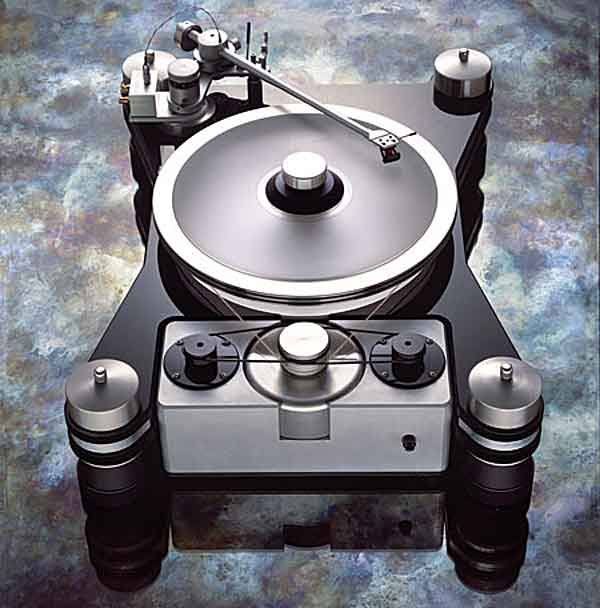 |
VPI JMW-12.6: $3000 $$$ ✩ Unipivot tonearm features vestigial antiskating, which disconcerted MF. Nonetheless, he enthused over its lush midrange, ultra-smooth top end, and rock-solid imaging and soundstaging: 'subjectively, it seemed to have lower distortion than any other pivoted arm I've heard, but part of that might be the result of its smooooth frequency balance. Inner detail was outstanding." However, he added of the original 12.5 version, "I think there's a slight midbass exaggeration that may be part of the spreading warmth above this range, and which gives this arm its inviting midrange." BD says of the 12" version, "lowers the original's already low distortion. The background is blacker and the arm seems to float an infinite well of inner and low-level details. The tonal balance is more neutral, but combined with the TNT III or IV, is still warm and inviting." With the 12.5, Harry Weisfeld made small but important modifications to the 12" JMW that resulted in heightened rigidity, a reduced center of mass, and improved damping. What BD found most impressive was the "obvious-once-you-see-it" touch of the small V-groove machined into the top of the headshell. This allows the user to more easily gauge headshell tilt while setting azimuth. "Neat!" MF adds: "Luxurious midrange, low distortion, and ease of setup and use make this a very attractive arm if your "table can handle the length." Additional arm assemblies cost $600. (Vol.20 No.1, Vol.24 No.12, Vol.25 No.3; See BD's review of the VPI HR-X in Vol.29 No.5 Read Review Online) |
 |
VPI Classic-JMW: $1600 An upgraded version of VPI's JMW Memorial 10.5i, the Classic-JMW, included with VPI's Classic 3 turntable, uses a new stainless-steel armtube, a stronger, more massive bearing platform, and a more rigid base mount. Though lateral instability remained a problem, any adverse effects were inaudible, said Mikey. (Vol.34 No.10 Read Review Online) |
Комментариев нет:
Отправить комментарий